The 4th of July is famous for juicy hamburgers fresh off the grill. After an emergency or unplanned event, it’s important for everyone’s morale to still have access to traditional comfort foods if possible even in times of crisis. Incorporating home canned hamburger into your long-term emergency food supply will ensure that the simple comforts of a home-grown holiday are safe at hand.
Home canning hamburger meat can be a great addition to your long-term food storage, adding protein and flavor to your meals without requiring refrigeration. Canned ground beef can last 3 to 5 years without deteriorating in quality, and can be edible even longer. The meat is pre-cooked and can be opened and eaten straight out of the can in an emergency, or heated and served as part of a quick everyday meal.
When you pop open the can, you’ll have a layer of flavorful beef fat for frying, beef stock for a soup or stew, and ground hamburger meat for use in just about anything that calls for ground beef like tacos or pasta sauce. Since the beef is preserved in beef broth, it’s ideal for use in a dish that can incorporate both the meat and broth, such as a chili.
Ground beef can be canned as crumbles or as browned hamburger patties. Hamburger patties are more versatile as they can be removed whole and eaten as burgers, or crumbled when they’re used.
Related: 10 Long Shelf-Life Canned Foods Every Prepper Should Consider Stockpiling
Keep in mind that full hamburger patties often do not hold together well in the canning process, and you may have trouble removing them from the jar as a whole patty. If you’re hoping to have a full shelf stable hamburger to warm on the grill, experiment with different hamburger grinds and sizes to find a method that works for you.
Canning hamburger meat, as with canning any meat product, requires a pressure-canner. Never can meat or recipes using meat with the water bath canning method.
How to Pressure-Can Hamburger Meat
Canning Pressure: 10 lbs under 1000 ft elevation (See notes for high elevation)
Head-space: 1 inch
Processing Time: Pints – 75 minutes, Quarts – 90 minutes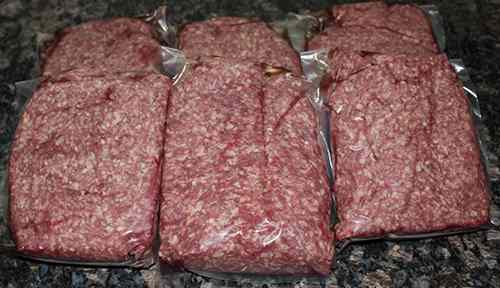
Begin by browning the meat in a pan in small batches with a little oil or fat of your choice. While the meat can be packed into jars raw, quickly browning it will greatly improve flavor and texture. A 10-inch cast iron can comfortably brown 1 pound of meat in 2-3 minutes, so work in batches until all the meat is just barely browned. A little raw still is ideal, so that it doesn’t toughen as it fully cooks in the canning process.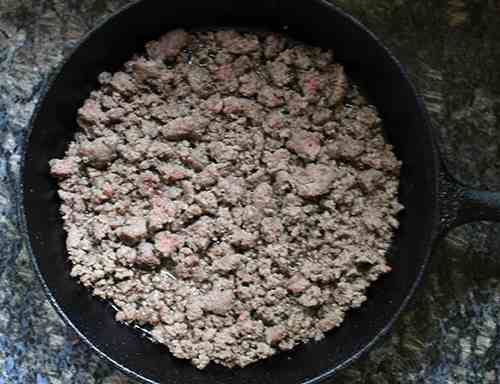
Season the meat to taste using salt and spices, but avoid using any recipes that include a starch or binder such as flour, egg, or bread crumbs. These ingredients can affect the canning process and cannot be used.
A pint jar can hold 3/4 to 1 pound of meat for canning, and a quart holds 1.5 to 2 pounds of meat. Try to have enough meat on hand to completely fill your pressure-canner, as it’s much more efficient to can a full batch.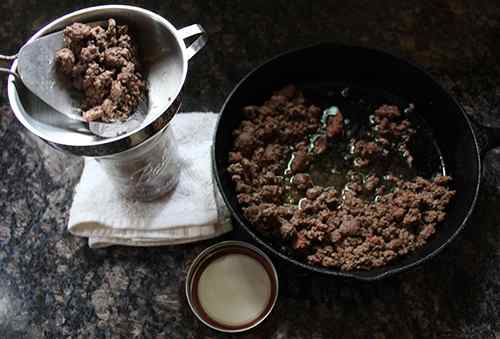
Add water to your pressure-canner and bring the water to a boil. Generally, instructions say add around 2 inches of water to the bottom, but this can vary based on your canner model.
Pack the browned meat into canning jars, pints or quarts, leaving 1 inch of head space below the rim. Fill the jars with boiling stock or water, still leaving 1 inch of headspace.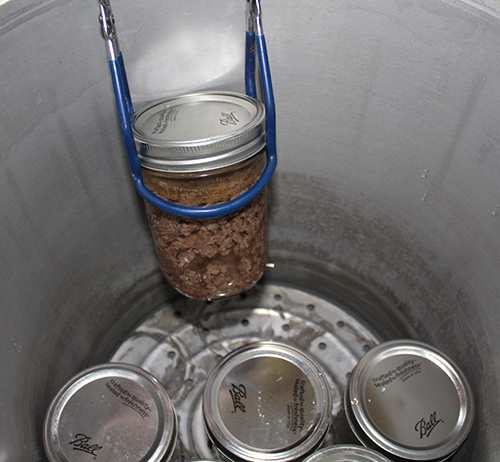
Cap the jars with clean, new canning lids, and attach a canning ring to each jar. The canning ring should be “finger tight.” If the ring is too lose, you’ll lose fluid into the canner and have partially filled jars, if the lid is too tight air can’t escape and the jars have a small risk of braking in the canner. Ideally, set the jar on the counter and tighten the lid as tight as it will go with one hand.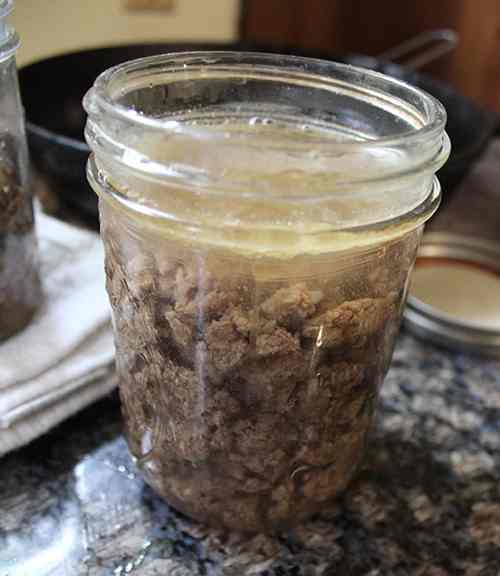
Once the band is tight enough that the jar itself begins to spin without the other hand holding it, it’s called “finger tight.” This part sounds scary, but really, there’s a huge range that’s acceptable, just don’t crank them down too tight.
Arrange the jars in your pressure-canner according to the instructions. If you have a large double-decker pressure-canner, be sure to insert the divider between layers and stagger the jars so that they’re not directly on top of each other.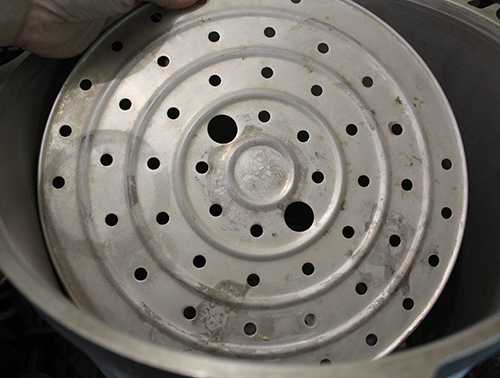
Seal the canner lid and for a weighted gauge canner, allow steam to escape from the valve for 7-10 minutes before adding the weighted pressure gauge. Use 10 pounds of pressure with a weighted gauge, or be sure to keep a dial pressure canner at or just above 11 pounds of pressure. 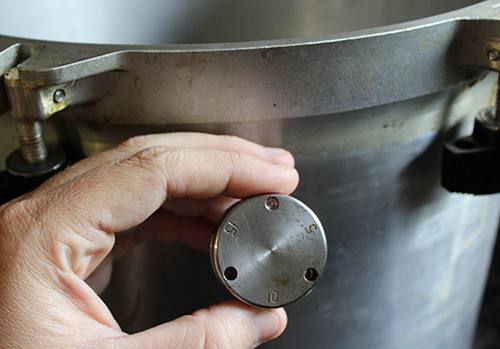
Once the canner is up to pressure, begin timing. Process for 75 minutes for pint jars and 90 minutes for quarts. 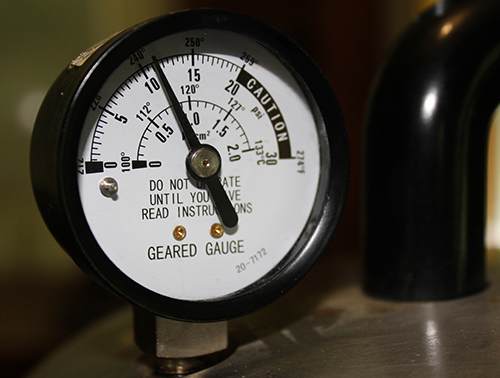 When the processing time is over, turn off the heat and leave the canner in place until it is back down to 0 pounds of pressure. Once it’s at 0 pounds, remove the weighted gauge to allow the last little bit of steam to escape before unscrewing the lid.
When the processing time is over, turn off the heat and leave the canner in place until it is back down to 0 pounds of pressure. Once it’s at 0 pounds, remove the weighted gauge to allow the last little bit of steam to escape before unscrewing the lid.
Remove the jars and allow them to cool to room temperature before storing. 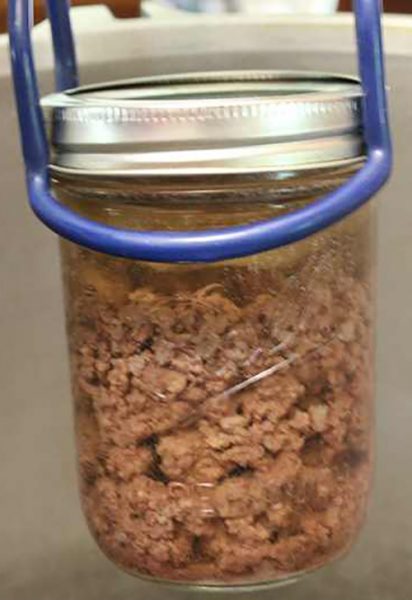
Be sure to remove the canning rings. Canning rings are only necessary during the canning process, and after the jars have cooled the vacuum from the seal itself will keep the canning lid sealed. Leaving rings on jars in storage can result in the rings rusting shut.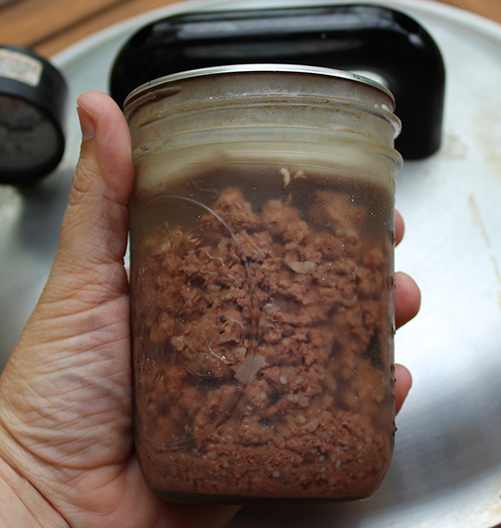
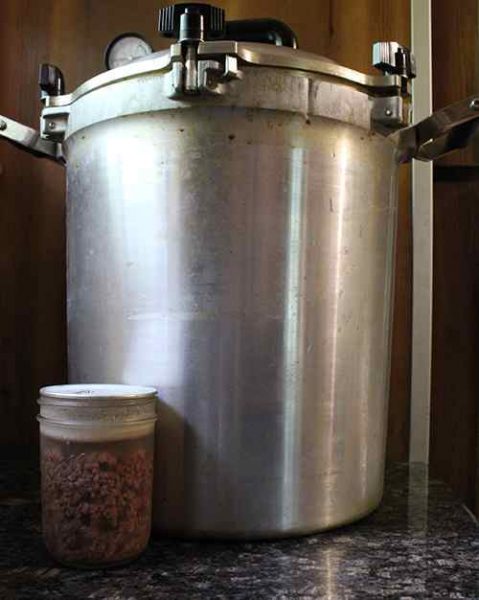
Notes: While many pressure-canners can accommodate a half gallon jar, the USDA does not approve canning meat in half gallon jars and does not provide canning timetables.
While some places on line will give you instructions for “dry canned” hamburger meat without using water or stock, this is not an approved method and will not guarantee food safety.
Above 1000 ft of elevation, canning pressure increases to make up for lower atmospheric pressure at high altitude. For high elevation pressure canning instructions, see in the All American Pressure Canning Instruction Manual.
Happy 4th of July!
You may also like:
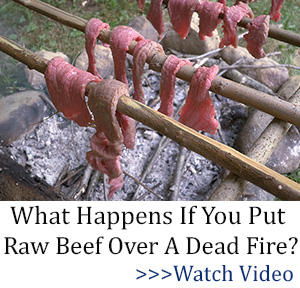 Delicious Recipes Using Cattails: “The Supermarket of the Swamp”
Delicious Recipes Using Cattails: “The Supermarket of the Swamp”
World’s Smallest Battery Powers House For 2 Days (Video)
How to Make Delicious Biltong with 1 Year-Shelf Life
How To Make Survival Dandelion Jelly with 2 Years Shelf Life

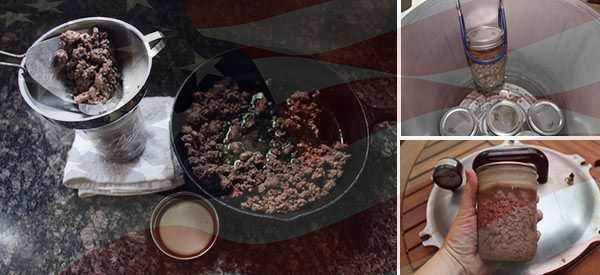













For canning above 1000 feet, it’s 15 pounds of pressure for any canning. I prefer broth when canning meat instead of water. It just adds a little extra flavor. I don’t add any seasonings except for above a half teaspoon of salt. That way, I can use the meat for whatever I want later and I’m not stuck with meat seasoned for one thing when I want to make something else requiring completely different seasonings.
Great point on the seasoning…
Homesteader, right on.
I am in total agreement regarding the use of broths in all my meat & chili canning. my entire turkey carcass is seasoned & pressure cooked @ 10# for the bones should remain stiff enough so as not to emulsify.
I like to be able to port the exhaust of my garbage disposal into sawdust to save steamed bonemeal as a separate fertilizer. Steaming beef bones I other larger bones; a garbage disposal requires a 1HP garbage disposal.
Thanks ! Heading to the mountains in a few months! Great info. God bless you and yours!
I have been canning meat now for many years. I buy meat for canning when it is on sale. Recently, in the last three years, I have experimented with also canning broth, meat fats, and butter. I use the same canning times as meat. I also use alternate jars besides official canning jars. I save all my pickle, spaghetti sauce, and those type jars and lids (that have the rubber seal in the lid) and can use them over and over. I can sausage, chicken, game of all kinds and make stews. I do not throw the carcass of turkey away after baking a turkey. I take all the bones, skin, giblets, and grease and boil it with water, my own herbs, salt, and pepper and strain to bottle in used fruit juice jars (mostly Santa Cruz Organic Juice jars. I wait until Kroger has juice on sale for 10/$10, then buy). Canning grease will be needed because eating too lean meat (like game) can give you protein poisoning. Canning butter is easy. Buy it when it’s on sale. Melt in a large pot. I melted 30 pounds. Pour liquid butter in pint jars and cap. Process in pressure canner same time as you would meat. Butter will separate out a little milk in the bottom. Don’t worry. Won’t hurt anything. I have canned turkey drippings, also. Haven’t tried bacon grease yet, but am saving some to try. Butters and greases will be sorely appreciated when you want flavoring for your cooking when times are tough. I have canned chicken, pork loin, Italian and Brat sausages, deer (also stews), spare ribs and kraut, and rabbit. I also don’t throw away any meat from the freezer that is too old for me to eat. I throw it all in roaster ovens to cook overnight and can the next day as “cat food” (or “dog food” if you have a dog). I try not to waste anything, if possible. Make vegetable soup from old freezer veges. Or just can them in water if you see you won’t be able to eat them from the freezer before they go bad. Use your imagination. Also, I have been lately testing certain wild plants for palatability and will start trying my hand at canning them. I have already started canning spring wild onions. I have frozen Day Lily buds and will trying canning them, too. Might try canning up some cat tail hearts (from the stems). Go outside the box and think of what you can eat, then can it.
Suzie. You are a beautiful person! May I ask your approx. age? You have so much energy. I never thought of doing that to butter. Do you know, Can I use my regular pressure cooker for small batches of anything? i don’t want to spend, 2 or 3 hundred dollars for a canner, I won’t use or need.I am on the, down side, of aging. Anything canned, may outlive, me! Your family is so lucky to have you and so is your husband. Are you from European heritage? It sounds like it, being thrifty and frugal. You could start your own business, blogging about your information. GREAT THINGS TO LEARN FROM YOU. My hat, if off to you. Just wonderful ideas. I can’t compliment you enough. ♥
I have canned butter, like to think I did it right but in time it spoiled and I had to throw it all out. What do you think I did wrong?
Homestead heart on utube has a nice video on canning butter. It turned out perfect!
You didn’t do it wrong, dairy is unsafe to can. The Internet is an overflowing garden of unsafe canning ideas.
YouTube is crazy with terrible ideas. Be cautious. “I didn’t die yet” is not a food safety award.
You can buy a Carey electric pressure canner…I love it I now have 2 plus a power pressure xl that also cans. I paid a little over $100 on a 10 qt canner at bed bath and beyond with a coupon. It cans 4 qts or 5 pints. I LOVE IT (in my mid 60s)
Presto pressure canners are pretty cheap but you can look at the Goodwill or Salvation Army garage sales, Etc there are different canning groups on Facebook a lot of people have found some really cheap canners I would look through the groups like Rebel canners darn I can’t think of any other names there are a few good groups out there for canning and dehydrating presto it’s a lot lighter than the All-American but you can also get a Carey pressure canner for around $100 from Bed Bath & Beyond with their 20% off coupon
I just want to ask why can butter when it is so easy to make? It keeps for a long time when kept cool even without refrigeration. Just curious.
Susie, I have done many things when it comes to canning. I have never thought of half of what you do. I would love to be able to converse with you on line if it is possible. I have so many questions. My mind is spinning, thinking of all the possibilities. If it is ok, I will give you my email address.
Do you have a blog or a way that you do not mind to contact you?
Do you have a lot of great ideas I have never thought of. I appreciate your insight and your knowledge. Thank you.
Wow!! You have been a fountain of information, for which I am deeply grateful. Your suggestions are golden. Making cat food from freezer burned meat is brilliant! Thanks!
Susie Queue,
All I can say is Wow! Your shelves must be a thing of beauty.
I have a question for you…You seem very knowledgeable. I just tried canning ground beef 2 days ago but ran out of time to cook the last batch. The cans are loaded and ready to go but had to put them in the fridge. Can I still can them after being in the fridge like that? If so, is there anything special I need to do to them to make them usable? Any advise is appreciated!
Heidi
Great information
I would love to have a hard copy of “The Lost Ways”, but I just can’t afford it. Do you think you might lower the price at some later date?
Thanks’
Ben
YOU CAN ALWAYS LOOK FOR A USED COPY ON THE WEB, i FIND A LOT OF STUFF I CAN’T AFFORD ORIGINALLY THAT WAY.
Know what you mean!!! I’ve got book one, and derned happy about it, but I’m dying to get book 2 and can’t!!!!
I keep telling myself, maybe in just two months!! Well maybe in anothe,.….
Enjoyed your article about pressure canning hamburger. Would you choose canning over freeze drying if you had the capability? Longer shelf life and perhaps nutrient maintenance for sure for freeze dried if properly packaged (25 years). I can do both, and do, but have never processed meat other than freeze drying a little meat loaf.
I know your question was directed to the author but it doesn’t look like she’s going to answer you. I can tell you that a freeze dryer is just too expensive for a lot of folks, myself included. That is why we stick with canning, freezing and dehydrating. Besides, canning and dehydrating can be done without electricity, if need be. Freeze drying cannot.
Sure, freeze drying is a good way to go. More food can be stored in less space and it will last longer, however, you’ll need water to rehydrate and/or cook the food. With canned foods, you can just open the jar, eat the food and drink the broth/water, without cooking should conditions warrant. Dehydrated foods still contain some moisture and require less water to rehydrate.
All methods have their pros and cons. So I guess it really just boils down to personal preference and what you can afford.
Thank you! We still do some canning and pickling. You are correct about freeze drying, but much of it we have found quite palatable in the freeze-dried form (such as fruits). Some foods don’t rehydrate well and in those cases it does just fine when added to the recipe of the moment by taking on the moisture of the added-to food. I grow a lot of garlic and freeze dry it for vacuum packing which cannot be done safely any other way. I tried vacuum packing dried garlic and trust me, it doesn’t work. Freeze dried is great however. I don’t know what your budget is, but if you haven’t already you might look at the Harvest Right home freeze dryer. We’ve had ours for about a year and they do have an installment plan. We used our vacation savings to buy ours. You are also right about power. The system is automated and we do get more than our fair share of power outages here; it detects the outage and picks back up where it needs to and tells you that’s what it has done. They aren’t cheap but they are less than about 10% of the cost of the smallest commercial units. As far as power, our local grid has been going down with increasing frequency and duration so I am embarking on having a natural gas whole house standby generator installed. Life without electricity isn’t fun especially when you have life sustaining medical equipment to run as well. I have a backup battery for that but in a sustained outage what happens then?
As far as meat, I have only freeze dried meatloaf. I have it in Mylar with an oxygen absorber. Usually I use Mason jars under Food Saver vacuum with O2 absorbers for most everything else because I can see how it is doing. Mylar bags are good but you are flying on blind faith until you open them and then it might be “surprise surprise!”
To clarify, we never have to add more water for cooking with freeze dried; we simply add it as one would any ingredient and it has turned out just fine thus far. We have even freeze-dried ice cream sandwiches. Quite the surprise to others when they see ice-cream sandwiches in Mason jars sitting out on the shelf and never melting. “Astronaut ice cream” I think they call it. Banana slices never go brown (or apple) as long as I pre-treat them with a Kosher salt solution as recommended. We freeze dry kale and basil for cooking as well. After a year with our freeze-drier we are still learning and experimenting, but do still can things like jalapeños. We did can our tomato sauce but learned we can freeze dry that easily as well. If 3k is in your budget and your power supply is sufficient (need a 20 amp outlet), it is a great way to go. I know they talk about doing meat, chicken, fish etc but until I open that Mylar bag with meatloaf in it I won’t be inclined to try it. I’d pressure can it instead, but a 25 year shelf life does beat a 3-5 year one for sure. Can’t can ice cream or yogurt either. But then I don’t like non-pickled jalapeños either so I’ll be canning them for the duration!
Thanks so much for your response. I enjoy and save all your articles. Some call me a “prepper” but I think of myself more as a “preparer”. I was all set for Y2K and my kids made fun of me when it didn’t go south, but I told them “go right ahead, you would have thanked me had the 50% of experts been right!” I was prepared to take care of my family and that is what counted.
drscot
P.S. We have also successfully freeze dried avocado slices. I also pre-treat them with the salt solution, and when finished they look and taste great. Friends and family thought we put artificial avocados in the Mason jars because they looked so perfect. Boy were they surprised to learn they were the real deal! I think salt would work well to prevent browning for dehydrating as well and it is better and cheaper than any of the other methods in common use. I watched a well-designed home experiment before using it. If you aren’t familiar with it let me know and I’ll pass it on to you.
I don’t doubt that a freezer dryer is nice. It’s been a while, but I have been to the Harvest Right website and looked over their offerings. But I’m on a fixed income with three mouths to feed and a roof to keep over our heads. That freeze dryer is an unreachable, and unnecessary, luxury. (I was forced into an early retirement due to some health issues.) I am thankful that I was able to invest in an Excalibur dehydrator and an All American canner before I had to quit work so that I can at least preserve the garden. I’m living my own little SHTF situation right now.
The reason for my statement about requiring more water for freeze-dried food is that about thirty years ago, and due to my job at that time, I was witness to the aftermath of a couple of young men eating some freeze-dried food without rehydrating it and not consuming enough liquid while eating. They only drank a can of soda each. They ended up in the hospital for a few days on IVs to try to get rehydrated. It was first thought that they had a bad case of food poisoning until they finally admitted what they had done. After seeing that, I can only imagine what would happen in a situation where all one had to eat was freeze-dried food and little water. I’d probably be praying for rain.
Sounds like we have had very similar situations but just different outcomes. If I didn’t have enough water to rehydrate the food in a conventional manner then it isn’t likely that there would be enough water to sustain life, and at that point it would be academic. However, I do have a pond available and a British military filter that I’ve had since Y2K. The guys you mentioned probably just didn’t think that one through I would say; kind of like eating one of those compressed sponges and then wondering why you got a tummy ache with constipation! We eat our freeze-dried ice-cream and fruit without any more than usual water and don’t have any problems. Maybe their food was contaminated somehow? Just guessing. And you are correct, there are issues with power etc using the freeze dryer. Power outages here are about as common to me as the sight of the back of my hand and getting worse, so I’m fixing to have a natural gas backup generator (Generac) installed promptly. I would sell and move if I couldn’t afford one. It’s bad and getting worse.
As I said, we still can but also freeze dry. I also have a dehydrator but it never worked out as well as the freeze-dryer so it sits in my closet. Herbs and greens remain at nearly full volume freeze-dried, but when I tried dehydrating it shrunk up to almost nothing.
Well I hope your situation improves. I have been there and done that. If it weren’t for the rabbits I raised and slaughtered, my kids would have had no meat to eat, and for my beat up old 62 Chevy pickup that the tailgate would fall off when I hit pot holes while carrying scrap metal to sell I would have had no cash. Trust me, I’ve been there!
Bless your heart. Have almost been where you were. Just invested in a Presto Canner (very affordable). Going to try my hand at canning hamburger meat. Unfortunately, what was on sale is 73/27 @ $2.00 per #. Hope it isn’t too much fat to drain.
I have been very curious about the freeze dryer reading your post was very enlightening do you eat the avocados freeze dried or do you rehydrate them how about your bananas and apples also I have heard about the ice cream sandwiches how do they taste freeze-dried? I do believe when I move I am going to purchase one thank you so much
Thank you so much for publishing the correct way to can meat following approved canning methods. A previous article used unsafe methods and caused alot of concern to many of us. These directions are much safer. Thank you to Ask a Prepper for publishing safer information.
Do NOT bring water to boil in canner! That is hotter than the jars and can break them. The water in the canner should be hot so that it will not shock the hot jars of food when you load the canner. That’s why you don’t put jars into cold water, too. Hot water from the tap is hot enough to use in the canner without breaking the jars and much easier on the workload. The canning process will heat that water beyond boiling.
i use cold pack, cold water in the canner, then start it. Takes longer, but works.
I’ve only ever used a water bath canner, so maybe it’s not the same scenario here, but for my water bath canner, I keep the jar in near-boiling water right up until I’m ready to use them. I also prefer to hot pack rather than cold pack.
If you start with very hot jars and lids and rings, then spoon the cooked food plus boiling broth or water in each of the jar, I should think the temperature difference between the hot jar and boiling water wouldn’t be drastically different, and would avoid breakage.
I really want to take a class on pressure canning; around me all they offer is water bath canning and they’ll “talk about pressure canning.” I’d like at least one session hands on with someone who knows how before I try it on my own.
I hope you haven’t been using water bath technique for meat. It is truly a game of Russian Roulette with more than one chamber loaded. Boiling does not get the temperature high enough to kill Botulism organisms. You can only achieve that with steam under pressure. You are truly gambling with not only your life, but the lives of anyone else who eats it.
Now as far as a class, if you buy a quality pressure canner there should be easy to follow instructions. Classes are fun but unnecessary. Read and follow the instructions, but for gawd’s sake stop water bath canning foods that are not safe to do so, and throw away any that you have done in that manner. Some foods are safe for water bath canning and some are definitely NOT!!
Nope, all I’ve canned so far has been tomatoes, peaches, and jams. I have seen old recipes for canning meat by boiling the jars for 3 hours but didn’t feel that was safe.
You might find classes unnecessary, but I’d prefer having someone in the room with me who can see that I do it correctly. I’ve had food poisoning before, it’s not something I’d wish on anyone, and I’m in no hurry to give it to myself.
I live 433 ft MSL and the manual calls for 11 lbs of pressure here. There should be a reference chart for you to use. If you use fresh food, clean it properly and have good hygienic practices all the way around (both personal and equipment) food poisoning shouldn’t be an issue. Contamination from any source can cause that. If that is the case, a class may or may not be able to teach you everything you should know. But if a class suits your tastes and you can find one then go for it. Your County Extension agriculture office may at least have an expert to answer questions and have printed materials available. As far as having a bonafide class that may be a hit or miss issue. You know, funding and availability. But really, the County agent’s information and the instruction book should be enough to get you going and feeling competent.
The food poisoning was not from anything I canned. One time was from a commercially canned item that was too old, And one time it was from a restaurant where I’m sure someone didn’t wash hands when they should have.
I was in food service for about a decade and know about proper hygiene working around food.
We have a great adult education program here where they offer all sorts of classes and they do take suggestions. So, I’m thinking suggesting a “how to pressure can” class may let them know there are those of us who want to learn.
I think I’m at 23 ft above sea level. So, 10 lbs should do the trick.
Since you already know how to can, the only thing you need to learn is to pressure can. With a quality canner, like the All American Pressure Canner (my personal favorite), pressure canning is simple. It comes with a very comprehensive guide and the instructions are easy to follow. The only other thing you’ll need to know is your altitude because that affects the amount of pressure needed. Basically that is below 1,000 feet, you’d use 10 pounds of pressure, and above 1,000, it’s 15 pounds.
I had never used one until a few years ago. Now I don’t use anything else even when water bath canning would suffice. It is so much quicker than water bath canning.
If you still haven’t built up your confidence to plunge ahead and try pressure canning on your own and still want a class, you may try calling your local County Extension Office. They may know of a class somewhere.
Correction: “…the only thing you need to learn is to pressure can…” should read “…the only thing you need to learn is how to use the pressure canner…”. Sorry about that!
Thanks, Homesteader! The classes currently offered cover waterbath canning only. Frustrating for me, since I know how to do that.
I’m at sea level, so 10 lbs would be fine. I appreciate your letting me know the brand of pressure canner that works for you and that the guide in comprehensive!
The house I’m living in currently came with a ceramic stove, which is useless for canning, really. I tried canning peaches on it, and it took an age for the water to boil. I finally got a dual gas burner so I can get a good flame to can. I’d like to replace the kitchen cooker with gas, but I’d have to put the lines in for that, and I’m not all that happy with the kitchen layout, so tearing out the current stove wouldn’t make sense until I’m ready to pull out, put in lines and change the layout, which is costly.
Do you have a community college with a adult education department near you? They sometimes have classes on various subjects that sometimes includes things like cooking or food preservation. What about a senior citizen center? They may let you put up a notice that you would like to learn pressure canning and was wondering if anyone there knew how. These are a couple of long shots but it’s about the best I can come with to give you ideas on finding someone to teach you. Wish I could be of more help.
Thanks for the suggestions. When I responded to drscot’s latest comment, I did mention we have a very active adult education program here, and will suggest a “how to pressure can” class.
I didn’t think about asking at a sr. citizen center. That’s a good idea. My knitting hostess (we meet weekly) will be 94 in December, but she never canned. Her parents did, but she married a career Air Force man, and with all the military moves, it didn’t seem worth it to her to do. I might also ask around at the church I’ve been attending. I’m sure there are one or two people there who have done the pressure canning thing.
I understand about AF moves. My now-ex and I are both Air Force retirees. We lived off base a lot and at one station, we had a neighbor who gardened and canned and thought we should too. She taught us how to garden and water bath can but not pressure can. That was in the 80’s. I didn’t start canning again until about 8 years ago when my son moved in with me and started his garden. Together we can, freeze or dehydrate the harvest.
Ceramic (glass) stove tops are not recommended but can be used if you choose a smaller canner and willing to risk it. I have a glass top stove and chose the 15 qt. All American canner. I’ve seen other people use the 21 qt on U-Tube but I’m not that courageous.
I knew a woman who canned on a rocket stove.
Oh, and I’ve made tons of pickles. forgot to add that to the list.
I always sterilize my clean jars by placing them upside down in the canner while bringing the water up to boiling, and preparing whatever is going into the jars. Care must be taken when taking them out to fill, such as using oven mitts and placing them on a towel by the stovetop when filling. Sometimes the jars tip over in the canner, but I use a long handled wooden spoon to lift them, carefully pouring the water out of the jar, then using an oven mitt to place it on my towel. No cracked jars! I also have a round cake pan on another stove eye to heat my lids and rings, and a magnetic tool to lift them out of the hot water. This has worked well for me. Hope this helps.
I canned hamburger and also made sloppy Joes and
meat loaf and taco meat
I live in the San Antonio, Texas area and would like to know if there is anyone in this area that gives classes in how to do some of the processes mention. I have canned but not in lots of years so some of my knowledge is gone or outdated.
Call the county extension agent. If they don’t have a class, they may know of one.
I loved the article. When I was younger my mother did not have a pressure canner and she canned meat in the water bath method, Cooked for 3 hours. no one got sick and she never lost a jar.
Water bath canning of meats apparently worked for your mother, but it is very much like playing Russian Roulette. Just because you hit an empty chamber this time or the next doesn’t mean you always will, and botulism is odorless, colorless, and tasteless. You won’t know you’ve got it until you have developed slurred speech and double vision, and by that time it is too late for effective intervention. Prevention by accepted pressure canning methods is 100% effective. The difference between botulism and Russian Roulette is that you will know you got botulism! Also akin to a bootlegger who doesn’t use “approved” methods and materials: he winds up selling methanol instead of ethanol and the lucky ones just wind up blind. The others are dead. I hope nobody reads that article and thinks it is okay to water bath can meats because somebody somewhere will ultimately wind up poisoned and dead. I realize parents or grandparents may have done things differently “back in the day” but it doesn’t mean methods were safe then or now. Stick to the tried and true. If you insist otherwise, make sure you are the ONLY one eating it!
P.S.
The way I understand it, the reason water bath canning won’t do the trick no matter how long you boil it is that you cannot get the temperature high enough to kill botulism organisms, which are very fastidious. Simple boiling won’t kill them. It is a matter of physics and biology. Put that same water under pressure as happens in a pressure canner and the temperature required to kill them CAN be achieved. Results by sheer luck is no substitute for proper canning methods which is pure science.
How do you make 4th of July (AKA: Independence day) hamburger patties with canned meat?
The only way I know of to make burgers from canned meat is to either make the patties before canning them or pack the raw ground beef into the jars and can. Raw ground beef will cook into a solid chunk in the canner. You would have to use wide-mouth jars so the meat would slide out easier. Then simply slice the meat into serving portions. I’ve never tried it so I don’t know what the end product would be like. I’ve only canned ground beef that has been pre-cooked and crumbled, which we then use in the casseroles and soups that we eat a lot. My suggestion would be to get enough ground beef to fill about 4or 5 jars and experiment. Once you have the end product that you like, then do a full canner.
Hi there, I would think that a whole jar full of raw meat would be difficult to get the right temperature clear through to the center of the mass of raw m?
Just a thought
I can raw chicken breasts and raw beef chunks without any problem. They come out fork tender. However, when it comes to ground beef, I cook it first, then can the crumbled meat. We prefer having the loose meat since it gives us more options and we’re not big burger people.
That said, a solid mass of ground beef would probably still cook without any problems. It would be in the canner for 90 minutes after the canner reached 10 or 15 pounds of pressure, depending on altitude. Pressure doesn’t start building in a canner until its temperature nears 250 degrees. This 90 minutes does not include the heat up time nor the cool down time required when using a pressure canner. So the meat is being cooked for more than 2 hours and usually continues to boil in the jar for several minutes after removing from the canner.
Does that clarify things a little or make them worse?!
The only way to get a hamburger patty from the canning process is to form the raw hamburger into patties that will fit the canning jar and place them in the jar.. Then pressure can them. I read an article somewhere on this sight that gave all the precise instructions as to how to can the patties. You might use a search engine to find this information. Hope this helps.
I have had success with putting double parchment paper, cut into circles, between the raw patties placed in wide mouth jars before pressure canning. The patties will be fragile, so be careful when removing the finished patties from the jar.
Im a lone man that does can. Comort foods will be nice. Hamburgers, bacon and eggs, stews, all possible. I have done powdered eggs for years, works fine. Making a batch of deer pemmican now. Have another fresh deer on ice waiting. Im into survival, preper foods. The pemmican, where you melt the beef fat and mix with dried, powdered meat is phenomenal as a survival food. Tattler reusable canning lids….My mother cans in anything that has a rubber seal. Saves pickle, picante, mayo jars and such. Buf, Im pushin fifty, so she is pushin seventy and slowing down some. But, we live in poor SW AR, so all ,my life, she canned anything that would fit in a jar. Her mother did too. For 20 years we had 50,000 chickens laying 30,000 eggs a day. Plus the cows, goats, pigs, and wild game. Always had a full garden. Dad got industrious and we had 6,000 watermelons to move this summer. My brother brought mother some squirrels. Next morning she cooked fried squirrel, eggs, cat head biscuits, gravy, she cooks heads and all. Sticks a fork in the eyeball hole and pops the top off to eat.the brains. We all live close.
Only use a pressure canner for meats. Cousin neighbor water bathed some a few years ago and liked to have killed everybody on that hill. It was deer meat. When you put pressure on water, it raises the boiling point. Which is raising the temperature that the inside of the canner gets up to. Same with your vehicle radiator. This is serious stuff, but fine if you pressure can it, following directions. I would still cook it a little after unjarring it, if possible. Canned food lasts. I made dinner last week with canned food that expired seven years ago, do it all the time. If it smells all right, I will cook with it.
Important to study up on alfatoxin, how to recognize, kill it, prevent it. It is a killer that will be common in a grid.down.
I am a lot.of information. I am offering what I know.
CW, just have to ask- What’s a cat’s head biscuit?
Would it work if you didn’t put water or stock in your jar?
It probably would be OK since there are fats and some liquids in the meat that would cook out in the canning process. For my preference, the stock helps keep the meat from becoming dry, especially when canning ground beef since it has already been cooked, plus it helps to add a little flavor. Later, you have some rich stock to use when making things like soup, or the stock can be drained off and used for something else or poured over the dog’s food.
Yep. I raw pack, dry can my foods. All of them. I then PC. And I PC because I think it’s faster than water bathing them.
The food comes out with more taste as the added water doesn’t leach all the flavor and nutrients out of the food. Think about soup. Perhaps I’m the only one, but once veggies and especially meat have been cooked for several hours in water, the resulting veggies and meat are to me, tasteless.
My foods come out with a “roasted” flavor – because basically that’s exactly what I have done, roasted them in the jar.
I had some ground beef canned by water bath before I read those articles about the dangers of food poisoning if it is not cooked in a pressure canner.Can I put those cans which were already cooked in the water bath into the pressure canner for a few minutes in order to make the meat safe to eat.
I cooked Chicken and pork then used the water bath way. Can I just use new lids then use the pressure canner I just got. I’m new to the pressure canner method, I helped Grandma and Mom when very young but didn’t retain the important stuff. But not afraid to read and learn. Thanks for any help.
Botula is a common soil born bacteria and it is understandable that it can contaminate garden grown foods. How does it contaminate meat?
It can come through cross contamination or commercially, from sabotage. Normally, large interior sections of muscle meat doesn’t get soil born bacteria in them. If the animal had botulism. I believe it would kill it the same as other mammals.
If you have a clean kitchen, fresh foods, have checked the jar rims to make sure there are no small chips on the rim, you’ve wiped the rim after filling to remove anything that might affect the seal, applied heated (but not boiled) lids and tightened, but not over tightened the ring (and NEVER retighten it AFTER it comes out of the canner. Just leave it alone until it’s cooled down or you can break the seal). If you’ve also kept the temperature at or slightly above the pressure for your altitude and for the called for time for whatever it is you’re processing. If you’ve left them alone for 12-24 hrs or so to cool completely, Then you should be just fine. Always check them before opening to make sure the seal hasn’t been breached and then it “resealed” itself – and you know this by the lid being easily removed or spoilage in the jar and usually a strong smell, you’ll be fine. And if in doubt, throw it out.
Hope this helps
Anyone know how to make ground beef not taste so mealy?
I find the texture off.(but I still eat it !)
Yes, it tends to be dry and mealy. But isn’t all ground meat? Put a sauce to it. If it’s pork, use spices. I put a red sauce over ground beef. All depends what I’m adding to the meal. The point of canning is to put it by as a base. Any meat will be gold when that is all you have.
Another tip. The canning books do not have the last instruction. Listen for the hiss as you open the jar, and boil the contents for 10 minutes. The old timers knew about spoiling. By the time you have the rest of “soup” or “sauce” ready to serve, it is safe. Sorry, as much as I like medium rare, there is no such in the canning world.
BTW, watch the Hailstones on “Life below Zero”. Most of their winter food is dried in the open air: meat, berries, greens. Oh yes, and their water supply is the river. So of course, the large pot of soup is a staple of their meals…. Unless they have fresh caught fish. Agnes has raised 7 children on this food, and now come the grandchildren.
How long will pressure canned ground beef last?
Pressure canned raw meat and it sealed nicely. I just opened a jar and it is slightly “pinkish” in the middle. Does anyone know if this is safe to cook and eat?
DOES canning meat with grease cut down the shelf life…………more grease should it be used asap? How much grease is too much
? Thanks